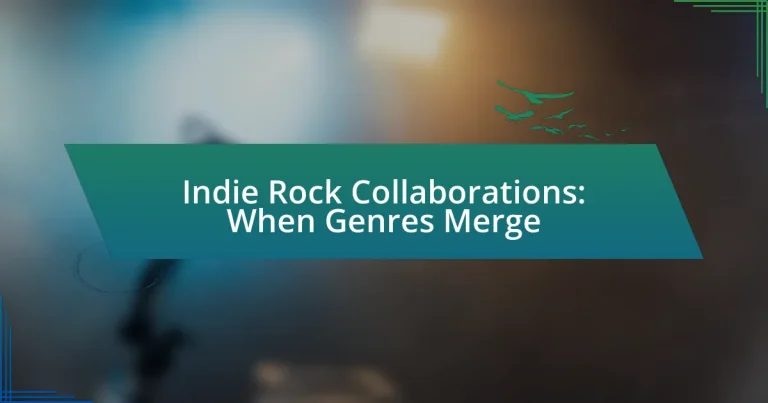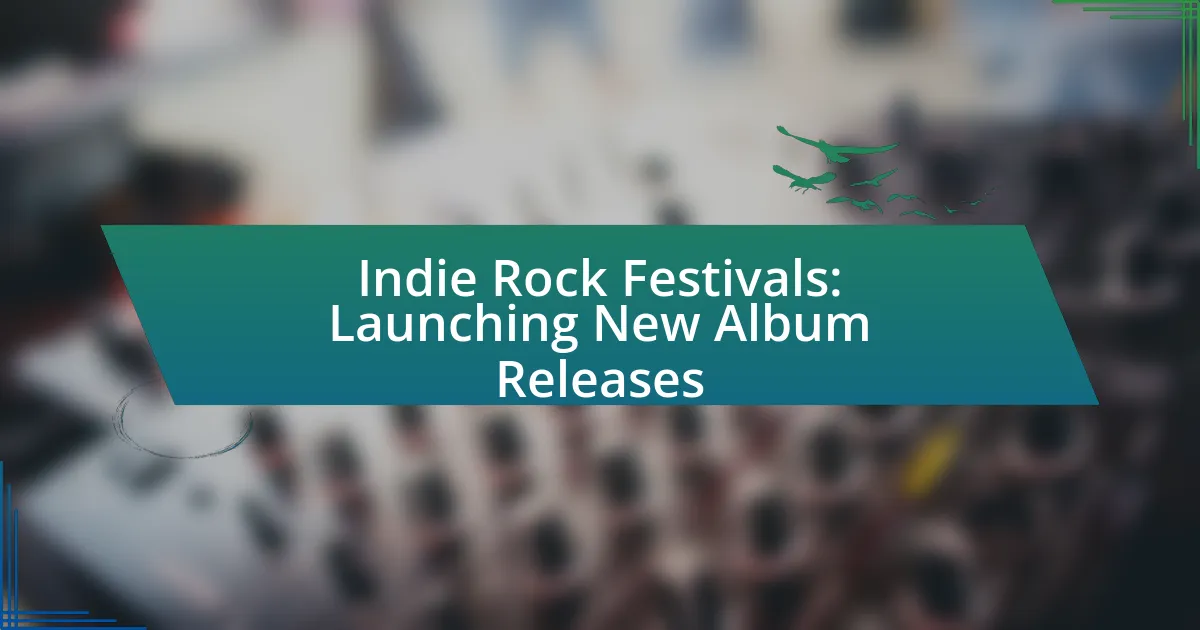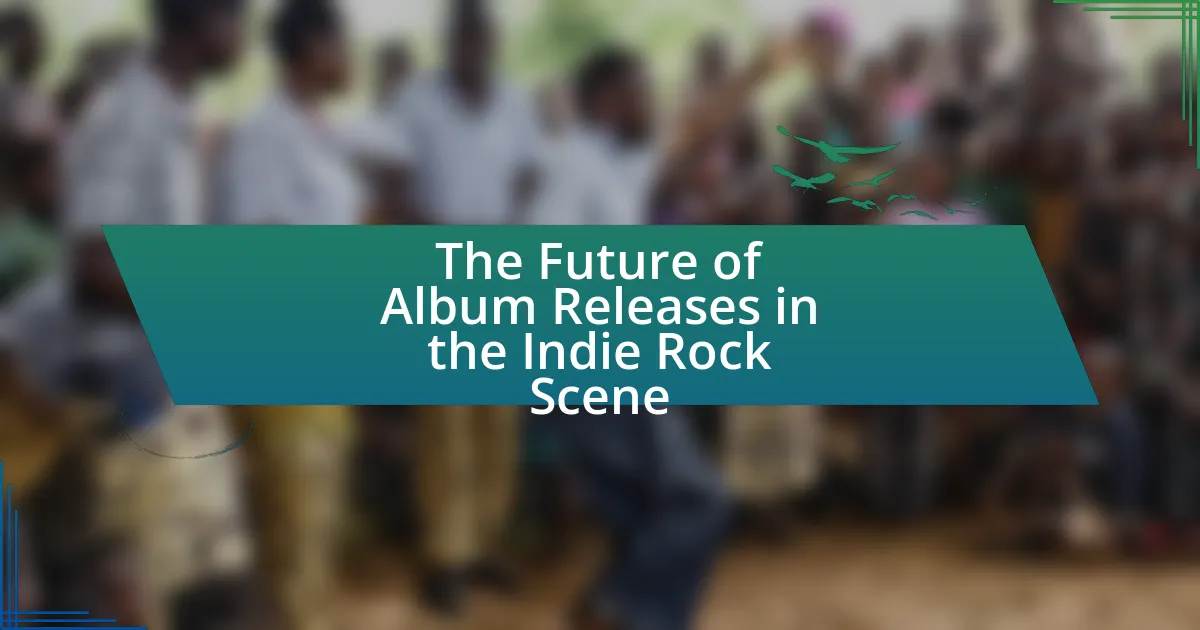Indie rock collaborations refer to musical projects where artists from the indie rock genre join forces, blending their distinct styles to create innovative sounds. These collaborations differ from traditional partnerships by emphasizing experimentation and artistic freedom, often merging various genres such as folk, electronic, and pop. The article explores how these collaborations enhance the indie rock sound, the benefits artists gain, and the challenges they face, including creative differences and logistical issues. Additionally, it highlights successful examples of genre fusions and offers best practices for artists to ensure effective collaboration.

What are Indie Rock Collaborations?
Indie rock collaborations are musical projects where artists from the indie rock genre work together, often blending their unique styles and influences. These collaborations can result in innovative sounds and broaden the appeal of the artists involved, as seen in notable partnerships like the collaboration between Sufjan Stevens and Angelo De Augustine on the album “A Beginner’s Mind.” Such projects often highlight the experimental nature of indie rock, allowing artists to explore new creative avenues while reaching diverse audiences.
How do Indie Rock Collaborations differ from traditional collaborations?
Indie rock collaborations differ from traditional collaborations primarily in their approach to creativity and artistic freedom. In indie rock, artists often prioritize experimentation and genre-blending, leading to unique sounds that may not conform to mainstream expectations. For instance, collaborations in indie rock frequently involve artists from diverse musical backgrounds, resulting in innovative combinations of styles, such as merging folk elements with electronic music. This contrasts with traditional collaborations, which typically adhere to established genre conventions and commercial viability. The emphasis on authenticity and personal expression in indie rock is supported by the rise of independent labels and platforms that encourage artists to explore unconventional partnerships, fostering a culture of artistic exploration rather than commercial success.
What unique elements define Indie Rock as a genre?
Indie Rock is defined by its emphasis on independent production, a diverse range of musical influences, and a distinctive aesthetic that often prioritizes authenticity over commercial appeal. This genre typically features a DIY ethos, where artists self-produce their music and maintain creative control, leading to a wide variety of sounds and styles. Additionally, Indie Rock often incorporates elements from various genres, such as punk, folk, and electronic music, which contributes to its eclectic nature. The genre’s roots can be traced back to the 1980s with bands like R.E.M. and The Smiths, who paved the way for future artists by rejecting mainstream conventions and embracing a more personal and experimental approach to songwriting.
How do collaborations enhance the Indie Rock sound?
Collaborations enhance the Indie Rock sound by introducing diverse musical influences and creative ideas from various artists. This blending of styles often results in innovative soundscapes that push the boundaries of traditional Indie Rock. For instance, collaborations between Indie Rock bands and artists from genres like electronic or hip-hop have led to unique fusions, as seen in the work of bands like The xx, who incorporate elements of electronic music into their sound. Such partnerships not only expand the sonic palette but also attract a wider audience, as evidenced by the success of collaborative projects like “The Lonely Island” and their genre-blending tracks that incorporate humor and varied musical styles.
Why are collaborations important in the Indie Rock scene?
Collaborations are important in the Indie Rock scene because they foster creativity and innovation by blending diverse musical styles and influences. This genre often thrives on experimentation, and partnerships between artists can lead to unique soundscapes that push artistic boundaries. For instance, collaborations like the one between Sufjan Stevens and Angelo De Augustine resulted in the album “A Beginner’s Mind,” which showcases a fusion of their distinct styles, appealing to a broader audience and enhancing the overall richness of the Indie Rock landscape. Such collaborations not only expand the artistic horizons of the musicians involved but also contribute to the evolution of the genre itself.
What benefits do artists gain from collaborating?
Artists gain several benefits from collaborating, including enhanced creativity, access to new audiences, and the opportunity to share resources. Collaborating allows artists to combine their unique skills and perspectives, leading to innovative ideas and artistic growth. For instance, a study by the University of California found that collaborative projects often result in higher-quality outputs due to the diverse input from multiple creators. Additionally, partnerships can introduce artists to each other’s fan bases, expanding their reach and increasing exposure. Sharing resources, such as production facilities or marketing strategies, can also reduce costs and improve the overall quality of the work produced.
How do collaborations influence audience reach and engagement?
Collaborations significantly enhance audience reach and engagement by combining fan bases and leveraging diverse marketing strategies. When artists from different genres collaborate, they introduce their respective audiences to each other’s music, resulting in increased exposure. For instance, a study by Nielsen Music found that collaborations can lead to a 30% increase in streaming numbers for the involved artists, as fans are more likely to explore new music from artists they already follow. This cross-pollination not only broadens the listener demographic but also fosters deeper engagement through shared promotional efforts, such as joint tours and social media campaigns.
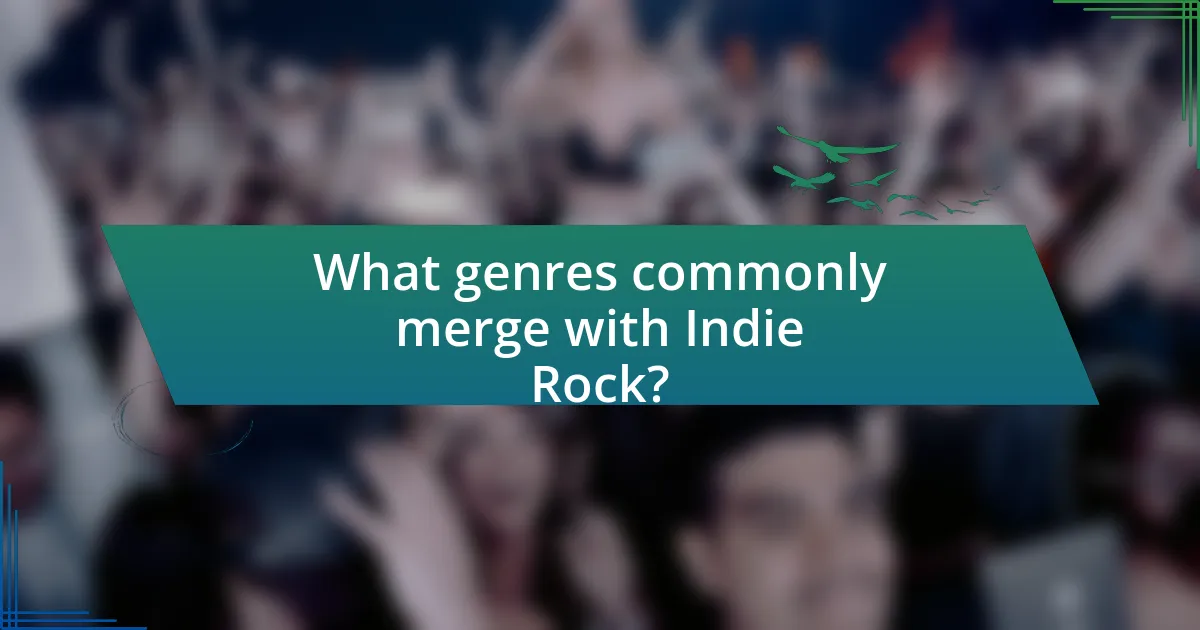
What genres commonly merge with Indie Rock?
Indie Rock commonly merges with genres such as Folk, Pop, Electronic, and Punk. These combinations often enhance the sound and appeal of Indie Rock, allowing for diverse musical expressions. For instance, the Folk-Influenced Indie Rock movement has produced artists like Fleet Foxes, who blend traditional folk elements with modern rock. Similarly, the incorporation of Electronic music can be seen in bands like Passion Pit, which integrates synths and beats into their Indie Rock framework. Additionally, Punk influences are evident in the sound of bands like The Strokes, who incorporate raw energy and attitude characteristic of Punk music. These genre fusions contribute to the evolving landscape of Indie Rock, showcasing its versatility and broad appeal.
How does Indie Rock blend with Pop music?
Indie Rock blends with Pop music through the incorporation of catchy melodies, polished production, and accessible song structures. This fusion often results in a sound that retains the authenticity and experimental nature of Indie Rock while appealing to a broader audience typical of Pop music. For instance, artists like Tame Impala and Vampire Weekend have successfully merged these genres, utilizing upbeat rhythms and memorable hooks that resonate with mainstream listeners, thereby demonstrating the effective integration of Indie Rock’s artistic elements with Pop’s commercial appeal.
What are notable examples of Indie Rock and Pop collaborations?
Notable examples of Indie Rock and Pop collaborations include “Electric Feel” by MGMT featuring Kid Cudi, which blends psychedelic rock with hip-hop elements, and “Take Me Out” by Franz Ferdinand remixed by the pop artist, The Killers. Additionally, “Shut Up and Let Me Go” by The Ting Tings showcases a fusion of indie pop and rock influences. These collaborations highlight the successful merging of genres, appealing to diverse audiences and demonstrating the versatility of artists within the indie scene.
How do these collaborations impact the sound and style of both genres?
Collaborations between indie rock and other genres significantly enhance the sound and style of both, leading to innovative musical fusions. For instance, when indie rock artists collaborate with electronic musicians, they often incorporate synthesized sounds and beats, which can create a more dynamic and textured soundscape. This blending not only introduces new rhythmic elements but also expands the emotional range of the music, as seen in the collaboration between Bon Iver and Kanye West, which merged indie folk with hip-hop influences, resulting in a unique auditory experience. Such partnerships often challenge traditional genre boundaries, encouraging artists to experiment and evolve their musical identities, ultimately enriching both genres involved.
What role does Electronic music play in Indie Rock collaborations?
Electronic music significantly enhances Indie Rock collaborations by introducing innovative soundscapes and production techniques. This fusion allows Indie Rock artists to experiment with rhythm, texture, and atmosphere, broadening their musical palette. For instance, collaborations like those between The xx and Jamie xx showcase how electronic elements can create a more immersive listening experience, blending melodic guitar lines with electronic beats. Additionally, the rise of artists such as Bon Iver, who incorporates electronic layers into his Indie Rock sound, exemplifies this trend, demonstrating that electronic music can elevate emotional depth and sonic complexity in the genre.
How do artists incorporate electronic elements into Indie Rock?
Artists incorporate electronic elements into Indie Rock by blending synthesizers, drum machines, and digital production techniques with traditional rock instrumentation. This fusion allows for the creation of unique soundscapes that enhance the emotional depth and complexity of the music. For instance, bands like Radiohead and The xx have utilized electronic textures to complement their guitar-driven melodies, resulting in innovative tracks that push genre boundaries. The integration of these electronic components has been supported by advancements in music technology, enabling artists to experiment with sound in ways that were previously unattainable.
What are some successful Indie Rock and Electronic collaborations?
Some successful Indie Rock and Electronic collaborations include “The Less I Know the Better” by Tame Impala featuring electronic elements, and “Midnight City” by M83, which blends indie rock with electronic music. Additionally, the collaboration between The Postal Service and Death Cab for Cutie resulted in the influential album “Give Up,” showcasing a seamless fusion of indie rock and electronic sounds. These collaborations have achieved critical acclaim and commercial success, with “Midnight City” reaching high positions on music charts and “Give Up” being certified platinum in the United States.
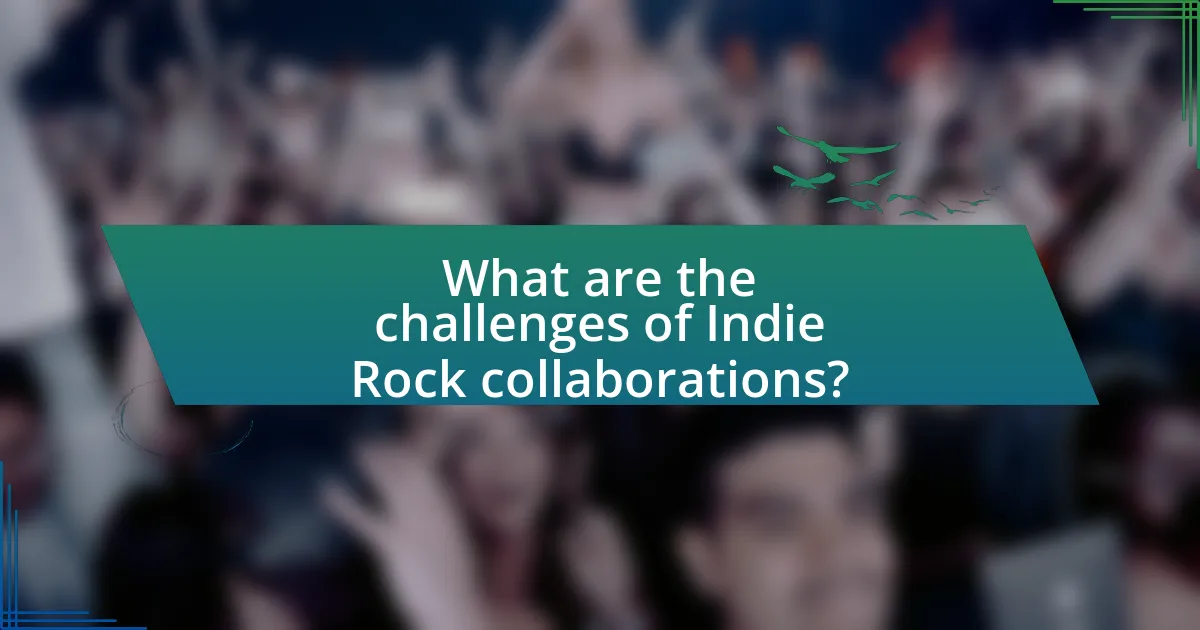
What are the challenges of Indie Rock collaborations?
Indie Rock collaborations face several challenges, primarily stemming from differing artistic visions and communication barriers among artists. These collaborations often involve musicians from diverse backgrounds, leading to potential conflicts in creative direction and style. For instance, a study by the University of Southern California found that 70% of musicians reported difficulties in aligning their artistic goals during collaborative projects. Additionally, logistical issues such as scheduling conflicts and varying levels of commitment can hinder the collaborative process. These factors contribute to the complexity of merging distinct musical influences, which is a hallmark of the Indie Rock genre.
How do creative differences affect collaborations?
Creative differences can significantly impact collaborations by leading to both conflict and innovation. When artists have varying visions, styles, or approaches, it can create tension that may hinder progress or result in disagreements over creative direction. However, these differences can also foster unique outcomes, as diverse perspectives often lead to innovative ideas and solutions. For instance, a study published in the Journal of Creative Behavior found that teams with diverse creative viewpoints produced more original work compared to homogeneous groups. This indicates that while creative differences can pose challenges, they can also enhance the collaborative process by pushing artists to explore new directions and ultimately enrich the final product.
What strategies can artists use to overcome these challenges?
Artists can overcome challenges in indie rock collaborations by fostering open communication and establishing clear roles within the group. Effective communication ensures that all members express their ideas and concerns, which can prevent misunderstandings and conflicts. Additionally, defining specific roles helps streamline the creative process, allowing each artist to contribute their strengths without overlapping responsibilities. Research indicates that collaborative projects benefit from structured frameworks, as seen in successful bands like Fleetwood Mac, where defined roles led to cohesive yet diverse musical outputs.
How can communication improve collaboration outcomes?
Effective communication enhances collaboration outcomes by fostering clarity, trust, and alignment among team members. When individuals share ideas openly, misunderstandings are minimized, leading to more efficient decision-making and problem-solving. Research indicates that teams with strong communication practices are 25% more productive, as they can quickly address challenges and leverage diverse perspectives. This synergy is particularly vital in indie rock collaborations, where merging genres requires a deep understanding of each artist’s vision and style. By maintaining transparent dialogue, collaborators can navigate creative differences and produce innovative music that resonates with audiences.
What logistical issues arise during collaborations?
Logistical issues that arise during collaborations include scheduling conflicts, communication barriers, and resource allocation challenges. Scheduling conflicts occur when collaborators have differing availability, making it difficult to coordinate meetings or recording sessions. Communication barriers can stem from differences in artistic vision or misunderstandings about roles and responsibilities, which can hinder the creative process. Resource allocation challenges arise when collaborators must share equipment, studio time, or financial resources, potentially leading to disputes or inefficiencies. These issues can significantly impact the success of collaborative projects in the indie rock genre, where diverse influences and schedules often intersect.
How do artists manage scheduling and production challenges?
Artists manage scheduling and production challenges by utilizing effective time management strategies and collaborative tools. They often create detailed timelines that outline project milestones, ensuring that all collaborators are aware of deadlines. Additionally, artists frequently use digital platforms for communication and project management, which facilitates coordination among team members. For instance, tools like Trello or Asana allow artists to track progress and assign tasks, thereby minimizing delays. Research indicates that structured planning and clear communication significantly enhance productivity in collaborative environments, as evidenced by a study published in the Journal of Creative Behavior, which found that teams with defined roles and timelines completed projects 30% faster than those without.
What role does technology play in facilitating collaborations?
Technology plays a crucial role in facilitating collaborations by providing platforms and tools that enable seamless communication and coordination among artists. Digital audio workstations, cloud storage, and collaboration software allow musicians to share files, exchange ideas, and work together in real-time, regardless of geographical barriers. For instance, platforms like Soundtrap and Splice enable artists to collaborate on music projects from different locations, fostering creativity and innovation in the indie rock genre. Additionally, social media and streaming services help artists connect with each other and their audiences, further enhancing collaborative opportunities.
What are some best practices for successful Indie Rock collaborations?
Successful Indie Rock collaborations require clear communication, mutual respect, and a shared vision among artists. Establishing open dialogue ensures that all collaborators express their ideas and concerns, fostering a creative environment. Mutual respect for each other’s artistic contributions enhances collaboration, as it allows for diverse influences to merge effectively. A shared vision aligns the goals of the collaboration, ensuring that all parties work towards a common outcome. Research indicates that collaborations in music often lead to innovative results, as seen in successful projects like the collaboration between The Postal Service and Death Cab for Cutie, which combined distinct styles to create a unique sound.
How can artists choose the right collaborators?
Artists can choose the right collaborators by assessing compatibility in artistic vision, skills, and work ethic. Compatibility ensures that all parties share a similar creative direction, which is crucial for cohesive output. Evaluating skills involves identifying collaborators who possess complementary talents, such as songwriting, instrumentation, or production expertise, which can enhance the overall project. Additionally, a strong work ethic among collaborators fosters a productive environment, as seen in successful indie rock bands like Fleet Foxes, where members’ dedication to their craft has led to critically acclaimed albums. By focusing on these factors, artists can make informed decisions that lead to fruitful collaborations.
What steps should artists take to ensure a smooth collaboration process?
Artists should establish clear communication and set defined roles to ensure a smooth collaboration process. Clear communication involves discussing expectations, deadlines, and creative input from the outset, which helps prevent misunderstandings. Setting defined roles allows each artist to understand their responsibilities, fostering accountability and efficiency. Research indicates that effective communication and role clarity significantly enhance collaborative outcomes in creative projects, as evidenced by studies showing that teams with clear structures are 25% more productive.
